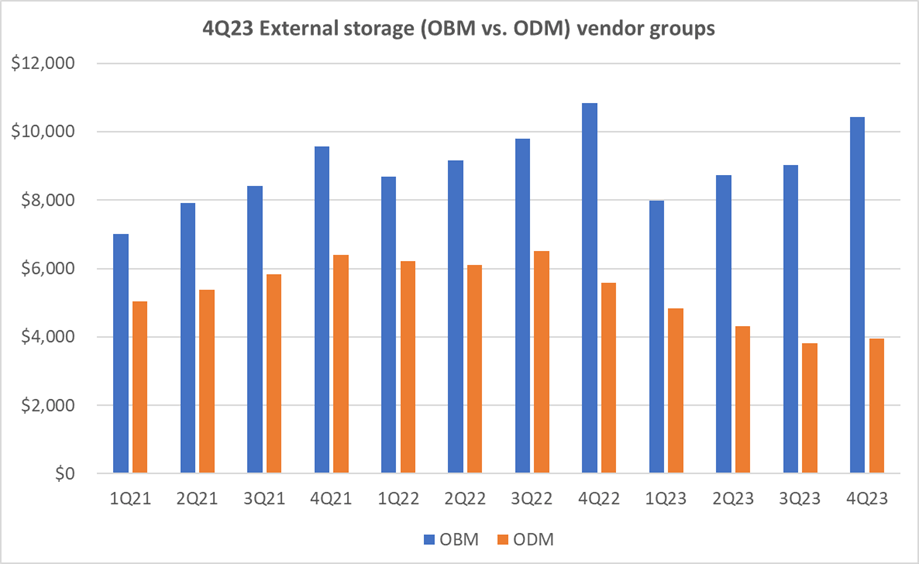This article originally appeared in the Omdia blog.
Data from Omdia’s latest data center storage revenue tracking has revealed that data center storage external systems decreased 12.5% year-over-year (YoY) to $14.4 billion but increased 11.9% quarter-over-quarter (QoQ) in the fourth quarter of 2023. In Q4 2023, data center storage revenues showed signs of recovery, as original design manufacturer (ODM) storage revenue drops leveled off and brand storage improved against historically high vendor revenues from the previous year.
Traditional Markets Showed Resilience, Cloud Storage Dipped
Data center storage markets were confronted with numerous obstacles from the outset of 2023, such as global inflation, US regional bank struggles, currency fluctuations, lingering supply shortages, and geopolitical tensions. Even amidst these ongoing challenges, signs of recovery began to emerge by the end of 2023. In the storage market graph below, shipments from ODMs, primarily catering to hyperscalers, experienced a significant decline in 2023. In contrast, original brand manufacturers (OBM), focusing on traditional storage, displayed greater reliance despite a year-over-year decline. For the full year of storage, the ODM group was down 31%, while the OBM group of vendors showed more resilience, with a 6% decrease in 2023.
Hyperscale data centers experienced declines in white box storage shipments from early in the year, while on-premises enterprise data centers were somewhat less affected. Towards the end of the year, OBMs saw an increase in storage shipments, and ODMs showed signs of recovery. By the fourth quarter of 2023, storage shipments into hyperscale had increased sequentially, marking its first such growth since 2022.

While in 2023 on-premises enterprise storage was not immune to threats of economic downturn, its impact was less pronounced compared to the cloud segment. The economic conditions of the last year did delay project timelines and hinder storage infrastructure investment refreshment for storage. Towards the end of 2023, storage shipments began to flow again, signaling renewed confidence and stability in traditional storage markets.
In 2023, OBM storage-as-a-service (StaaS) or subscription-based models emerged as a means for traditional vendors to push back against cloud pay-as-you-go business models. Branded storage vendors have indicated a strong upward trend for on-premises StaaS agreements. While subscription-based purchasing options promise long-term benefits for both customers and suppliers, their rapid adoption appears to have resulted in lower vendor revenues. Historically, the storage business has been software-driven since the introduction of software RAID protection. This reliance on software, coupled with high storage costs, has facilitated this swift adoption of these subscription-based models. Unlike traditional capital-based storage system sales, subscription revenue is recognized gradually over time, affecting the revenue reporting of branded storage for 2023.
Q4 2023 external storage vendor results, by company
For Q4 2023, OBM revenues were down 4% YoY, and ODM vendors were down about 29% YoY according to Omdia’s tracking. As illustrated in the chart below, other individual vendor highlights include:
- Dell EMC, after demonstrating growing strength in 2022, dropped back by 18% YoY in Q4 2023.
- Huawei continued to widen the gap between itself and the competition, up 1.5 points in Q4 2023 share.
- NetApp, after refocusing on on-premises storage, saw an increase in Q4 2023 but remained down for the year.
- Lenovo’s growth was buoyed by huge ODM+ shipments, while traditional lines were down YoY.
- IEIT Systems (Inspur) came back in Q4 2023 on improving strength from Chinese service providers.
Signs for 2024 Being a Better Year for Storage Shipments
Omdia expects an improvement in the outlook for storage shipments in 2024 because storage systems are the cornerstone of data management, and reinvestment in more storage capacity can only be curtailed for so long in this data-dependent economy. In the upcoming year, storage purchases are anticipated to be driven by factors like digital transformation, IoT expansion, various data analytics, and an increase in demand for artificial intelligence.
While the market has matured and cloud computing growth has slowed, Omdia predicts that the expansion of overall cloud services will grow at a robust 10% CAGR over the next five years. As we transition into the true hybrid cloud era, where workloads are moving in both directions, planners are placing and redistributing workloads between on-premises and cloud data centers in accordance with operating and data requirements. The need to reposition data and applications optimally has caused this shift, which has led to a more balanced demand across on-premises and cloud data center markets.
Furthermore, despite the past slowdown, the storage innovation and data management ecosystem will remain robust. Omdia still expects a 12% storage revenue CAGR through 2028. The full-year 2024 is expected to witness an overall storage growth rate of 11%, especially with cloud storage growth returns anticipated mid-year. This indicates promising prospects for storage markets going forward, as providers delve into novel approaches such as unstructured data management solutions, enhanced cybersecurity features, and high-performance scalable filesystem approaches to reignite interest and counteract the market decline observed in 2023. This continual innovation highlights the resilience of the storage industry and its capacity to adapt to changing requirements and obstacles, bolstering confidence in future growth and development.
Click here to read more insights and analysis covering market trends and industry forecasts prepared by Omdia’s Cloud and Data Center practice.




